
In a gust of good luck, you’ve finally found the perfect person to live with. Someone to share all the expenses and household chores. Things couldn’t get any better. Slowly, though, you start to notice little things – the thermostat has been set five degrees lower than you’d like, and a pile of dirty dishes in the sink has suddenly gone from a mole hill to a towering mountain. Lights are being left on. And on multiple occasions, you’ve come home to a blaring TV. Enough is enough. Let the battle begin!
When it comes to the perfect home, we all have our preferences and habits. Sometimes, we end up living with people who feel the same way, and sometimes we don’t. And when that happens, it’s not always quiet on the Western Front. So to see just what people fuss over when it comes to cohabitating, we asked 2,000 men and women to describe their perfect home preferences.
Curious to see how much you relate to other cohabitating households? Keep reading.
MY HOUSE, MY PREFERENCES
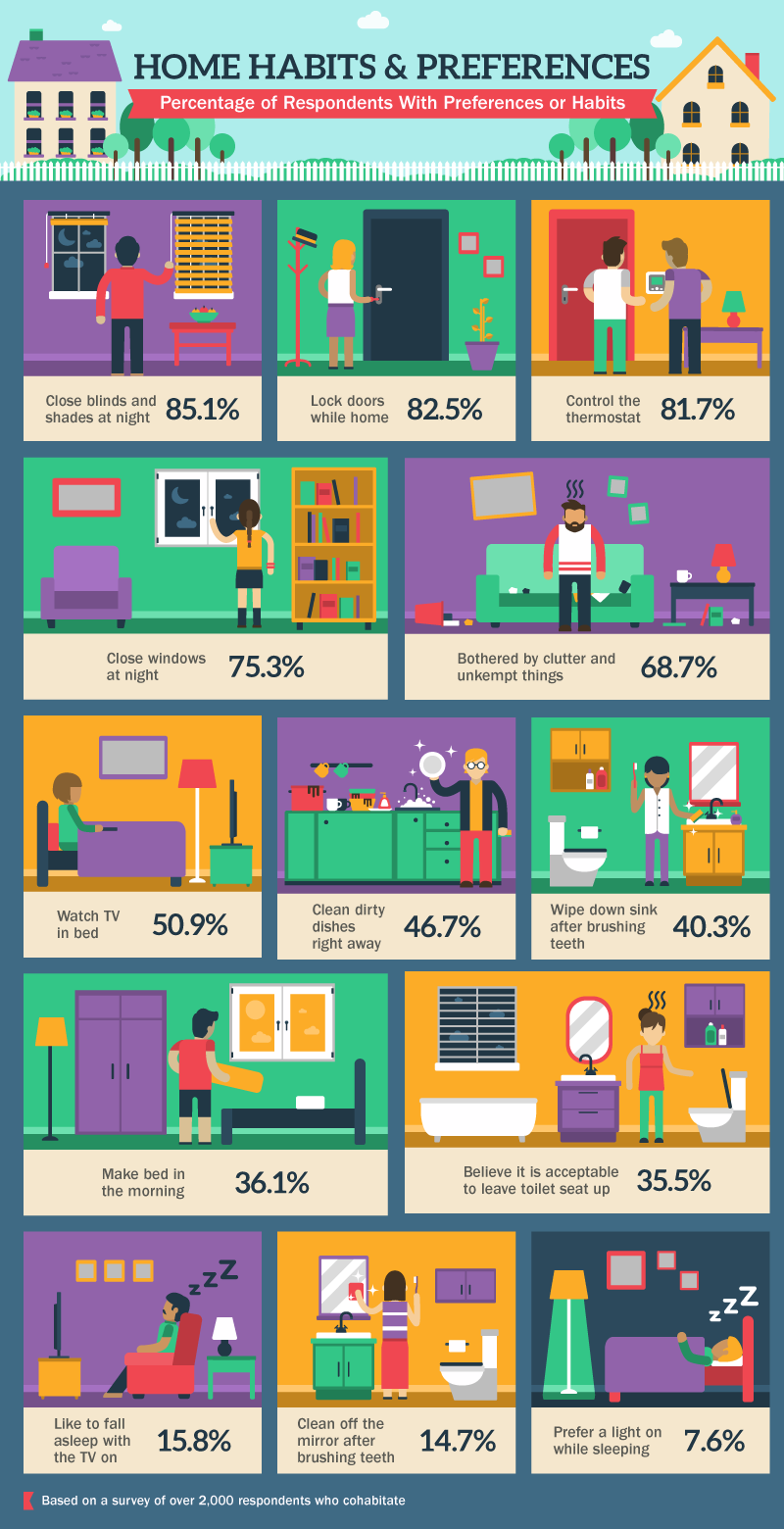
Cohabitation isn’t always the easiest. When you bring two or more distinct personalities under one roof, the expectation that preferences will easily align isn’t always reasonable. According to our cohabiters, preferences are all across the board – some considerate, others not so much.
If you’re like most people, you’d rather not have to worry about peeping toms. Our results show that more than 85 percent of respondents close blinds and shades at night, while more than 82 percent lock doors while home. If you’ve just moved in with someone with these preferences, it might be better to go along with it – leaving the window shades up or keeping the door unlocked while sleeping can easily turn into a cardinal sin. A higher source of tension? Controlling the thermostat. More than 80 percent of responses indicated that they preferred to control the air conditioner and heater.
And if you believe that it’s acceptable to leave the toilet seat up, you should probably start packing because less than 36 percent of survey takers agree with you. Even sleeping with the lights on is bound to make someone grumpy – less than 8 percent of respondents prefer this.
SHOCKING PREFERENCES
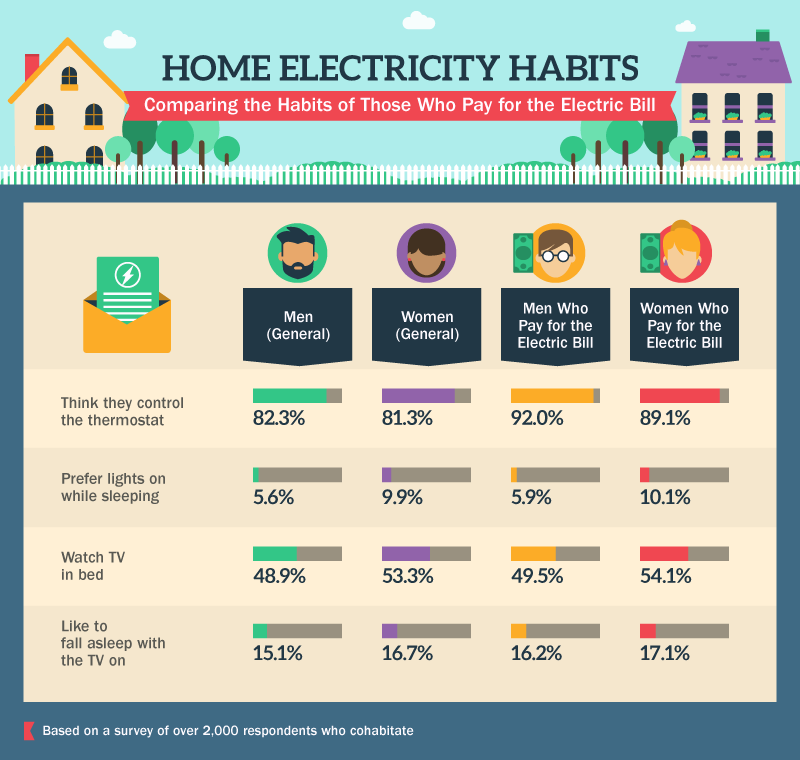
You’re the one who sends a nice fat check to the electric company each month. So if you want to turn the thermostat down as low as it can go or leave the lights on while sleeping, you should be able to, right? Think again. When it comes to battling over electricity, both men and women believe their preferences trump all.
In general, 82.3 percent of men think they have control over the thermostat – whether or not they pay the bill. At the same time, 81.3 percent of women believe the same thing. Yet when men and women do pay the electric bill, those percentages get higher: 92 percent for men and 89.1 percent for women. Your money, your rules.
Overall, more women prefer to sleep with the lights on and watch TV until they fall asleep. The same goes for women who are actually paying the electric bill.
BATTLE OF THE SEXES – HOME EDITION
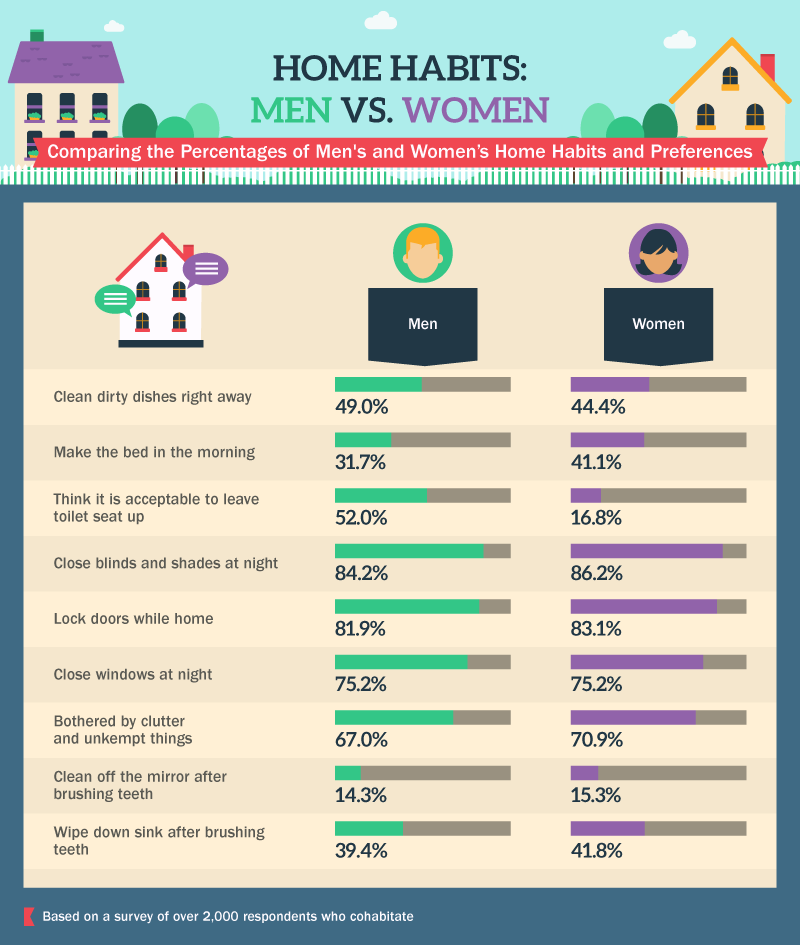
If you are living with a partner or a spouse, you’ll score major brownie points for being considerate of their habits and preferences. No one wants to be uncomfortable in their own home. So it was surprising to learn that 52 percent of men think it is acceptable to leave the toilet seat up – by far, easily one of the worst household faux pas. It says something that only 16.8 percent of women are OK with potentially falling into the toilet.
The good news is that men and women don’t really differ on any other major home habits. Both genders pretty much agree that it’s appropriate to the clean off the mirror after brushing your teeth, that blinds and windows should be closed at night, and that dirty dishes should be cleaned right away.
Making the bed in the morning, however, could be a source of contention – 31.7 percent of men enjoy coming home to a neat bed, and 41.1 percent of women are fine with taking some extra time to tidy it up.
Lesson learned: Take a few extra seconds to put down the toilet seat. It’ll make your life a whole lot easier.
GENERATIONS OF PREFERENCES AND HABITS
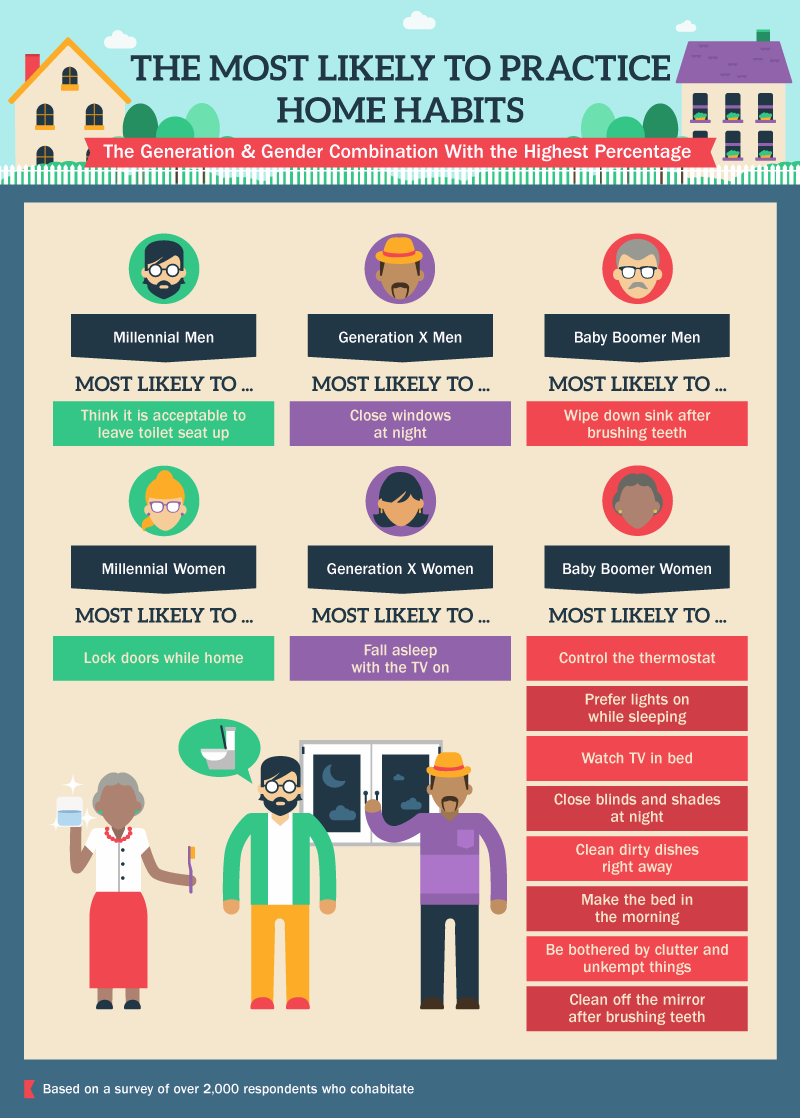
We all know that men and women can be very different. But how do the generations differ when it comes to practicing home habits? From the looks of it, some generations might have more preferences than others when it comes to keeping a happy home.
Millennial males are most likely to think it is acceptable to leave a toilet seat up, while millennial females are most likely to lock doors while home. Furthermore, Gen X males are most likely to close windows at night. Gen X females, on the other hand, are most likely to fall asleep with the TV on.
Do you believe older generations are more relaxed? Think again. Baby-boomer males might only really care about wiping down the sink after brushing their teeth, but baby-boomer females have a whole list of expectations – control over the thermostat, closing blinds and shades at night, and cleaning dirty dishes immediately. And if you’re planning on living with someone around this age, don’t even think about leaving stuff lying around. Baby-boomer females aren’t going to put up with it.
GENERATIONS OF TOILET SEAT BATTLES
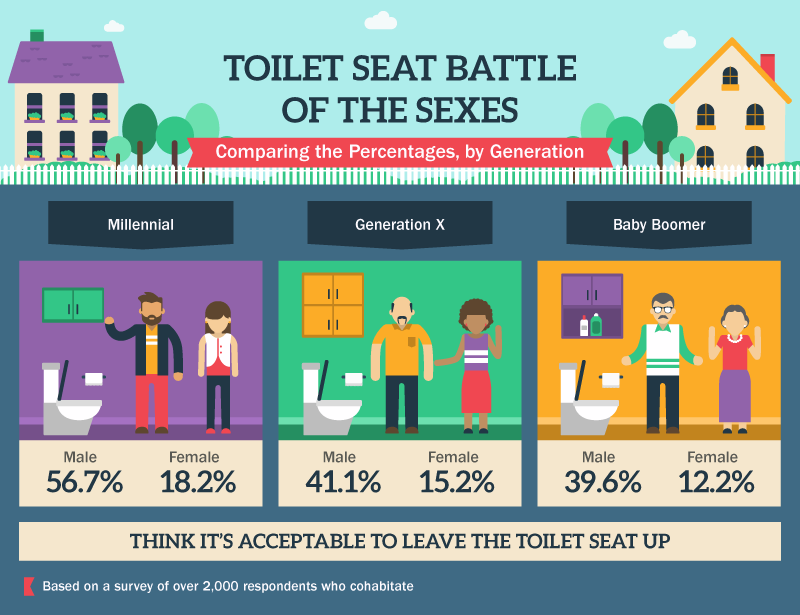
You might not believe this, but when it comes to the Great Toilet Seat Debate, the truth actually lies in a complex equation by researcher Jay Pil Choi. Whether or not you should leave the toilet seat down really depends on the number of women versus men in a household. But don’t expect too much. Men and women of all generations are going to do what they’re going to do, and a silly equation isn’t going to stop them.
It is evident that more men than women will always prefer it this way – 56.7 percent of millennial men find this acceptable; 41.1 percent of male Gen Xers and 39.6 percent of male baby boomers also prefer to see the same side of the lid.
Only 18.2 percent of millennial women think it’s acceptable to leave the toilet seat up. And as they age, this percentage only gets smaller. At least 15 to 12 percent of female Gen Xers and baby boomers are fazed by this lack of toilet etiquette.
THE GREAT TOILET DEBATE
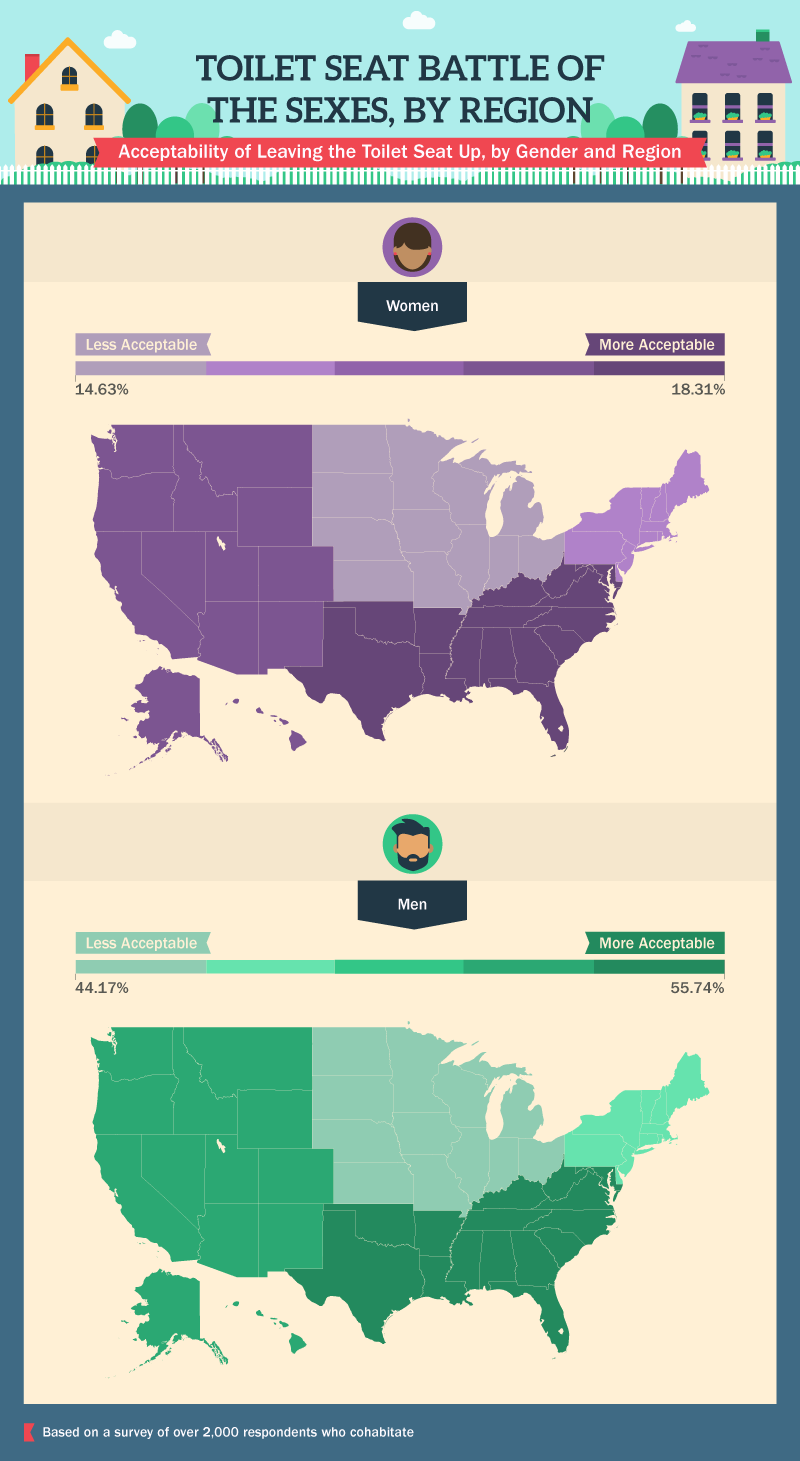
For years, the Great Toilet Debate has raged on: Should the lid remain up or down? Despite it being good manners to think of the person who’ll come in after you, men and women still grapple with toilet etiquette. Is it ever acceptable to leave the toilet seat up? According to our findings, the answer depends on the region.
If you’re a man living in the South and Southeast, then you probably don’t think much of it – you’re going to have to use the bathroom again, so what’s the point? About 56 percent of men in these regions think it’s acceptable to leave the lid up. Notably, though, men in the Midwest seem to have better manners because only 44 percent think the toilet seat should stand tall.
As a whole, women are more likely to be against this domestic problem. Again, women in the South and Southeast find it more acceptable to leave the toilet seat up: 18.3 percent. At the same time, women in the Midwest are the least likely to put up with this breach of chivalry: 14.6 percent.
If someone asks where Southern hospitality has gone to, just tell them it’s now in the Midwest.
GENERATIONS OF THERMOSTAT BATTLES
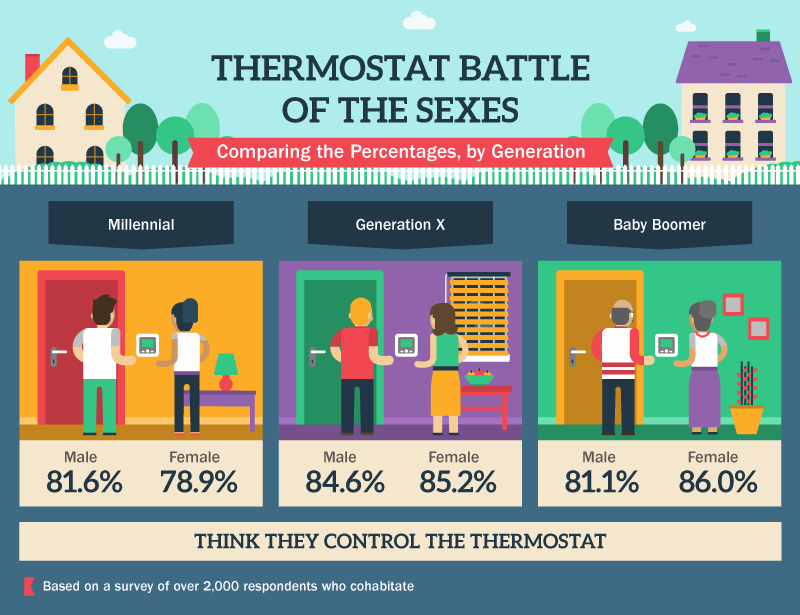
Last but not least, we asked our respondents across all generations whether they claimed control over the thermostat. When it comes to the youngest generation – millennials – 81.6 percent of males and 78.9 percent of females think they are in charge of the temperature. Interestingly, this is the only generation where more men than women feel this way.
This feeling is even stronger in Gen Xers – 84.6 percent of males think they are the king, while 85.2 percent of females know it’s really they who have all the power. Finally, for baby boomers, women seem to be a lot more confident in their control over the thermostat. While 81.1 percent of males around this age think they control the temperature in their house, an astounding 86 percent of females think the same thing.
It’s obvious that both men and women of all ages feel that they should be in control of the thermostat. But maybe the best thing to do is decide on a temperature you both can live with, and leave it at that.
BATTLE OVER THE THERMOSTAT
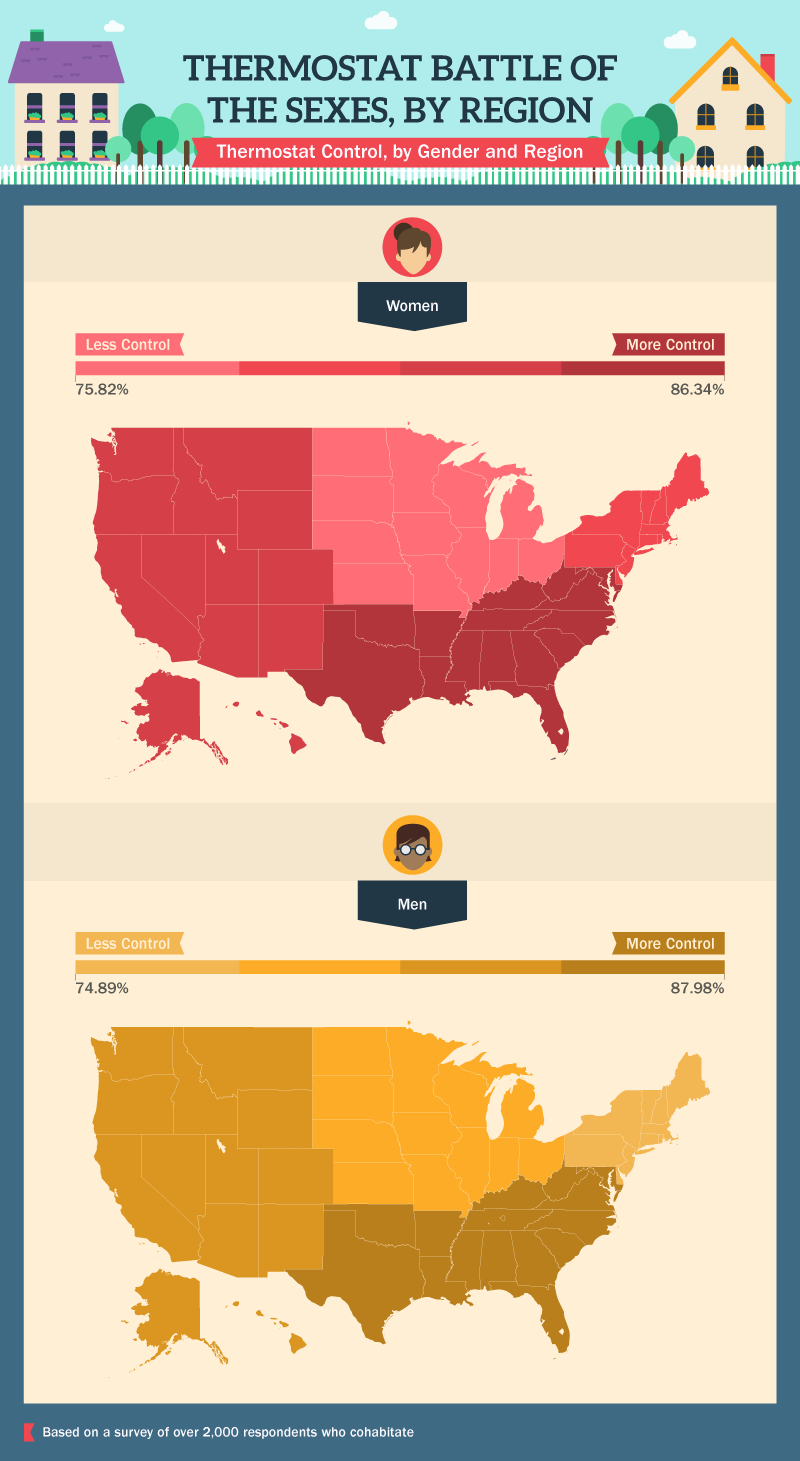
Anyone who has lived with someone else knows the struggle associated with the thermostat: there is no such thing as a perfect temperature when more than one person is involved. You can try all you want to sneak in and change it, but eventually, the house will always go back to being either a tundra or the Sahara Desert. With men preferring a colder house and women needing some additional warmth, it can sometimes be a futile game.
So where in the country do men and women feel they have the most control over the thermostat? It turns out that men and women in the South feel that they have the most thermostat dominance. At the other end of the spectrum, about 75 percent of men in the Northeast feel the same.
Overall, roughly the same percentage of men and women in the Northeast feel they have control over the thermostat – but is this imagined or actually true?
FINDING PEACE WHILE COHABITATING
If you live with other people, you’re not always going to agree on everything – especially when it comes to the house. You might want things done a certain way, while they might be thinking something entirely different. For example, you might like falling asleep to the sound of the TV, but the person you live with can’t stand it. At the same time, they may think it’s acceptable to leave the toilet seat up, which annoys you to no end. You might live with someone older, who likes to be in control of the thermostat, or someone younger, who thinks the doors should be locked even if you’re home.
Since we all have home preferences and habits, it’s always a good idea to talk about them with your roommate, spouse, partner, or even a family member (who’s visiting indefinitely). That way, you’ll know what to expect up front and hopefully, when the times comes, compromise will just be an easy step away.
SOURCES
- http://www.telegraph.co.uk/men/thinking-man/11880499/Should-men-put-the-toilet-seat-down-when-theyre-finished.html
- http://www.dailymail.co.uk/news/article-2574360/Thermostat-wars-leave-hot-bothered-One-four-married-couples-admit-arguing-temperature-control.html
- https://msu.edu/~choijay/etiquette.pdf
FAIR USE STATEMENT
We would love for you to share the assets covered on this page. The only requirement is that recognition is given to the author via a link to this article.


Are You Familiar With This Topic? Share Your Experience.